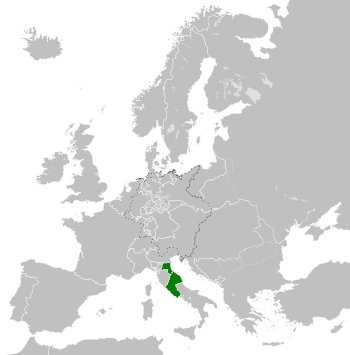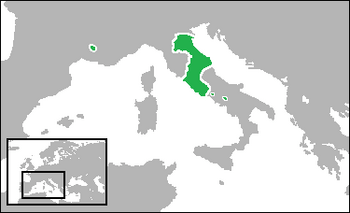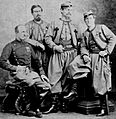Papal States facts for kids
Quick facts for kids
State of the Church
Stato della Chiesa
Status Ecclesiasticus |
|||||||||||||||||||||||
|---|---|---|---|---|---|---|---|---|---|---|---|---|---|---|---|---|---|---|---|---|---|---|---|
| 754–1870 Interregna (1798–1799, 1809–1814 and 1849) |
|||||||||||||||||||||||
|
[[Flag of Vatican City|Flag (1825–1849, 1849–1870)]]
|
|||||||||||||||||||||||

The Papal States in 1815 after the Napoleonic Wars
|
|||||||||||||||||||||||

Map of the Papal States (green) in 1700, including its exclaves of Benevento and Pontecorvo in Southern Italy, and the Comtat Venaissin and Avignon in Southern France.
|
|||||||||||||||||||||||
| Capital | Rome | ||||||||||||||||||||||
| Common languages | Latin, Italian, Occitan | ||||||||||||||||||||||
| Religion | Roman Catholic | ||||||||||||||||||||||
| Government | Theocratic absolute elective monarchy | ||||||||||||||||||||||
| Pope | |||||||||||||||||||||||
|
• 754–757
|
Stephen II (first) | ||||||||||||||||||||||
|
• 1846–1870
|
Pius IX (last) | ||||||||||||||||||||||
| Cardinal Secretary of State | |||||||||||||||||||||||
|
• 1551–1555
|
Girolamo Dandini (first) | ||||||||||||||||||||||
|
• 1848–1870
|
Giacomo Antonelli (last) | ||||||||||||||||||||||
| Prime Minister | |||||||||||||||||||||||
|
• 1848
|
Gabriele Ferretti (first) | ||||||||||||||||||||||
|
• 1848
|
Giuseppe Galletti (last) | ||||||||||||||||||||||
| History | |||||||||||||||||||||||
|
• Establishment
|
754 | ||||||||||||||||||||||
| 781 | |||||||||||||||||||||||
|
• Treaty of Venice (independence from the Holy Roman Empire)
|
1177 | ||||||||||||||||||||||
| February 15, 1798 | |||||||||||||||||||||||
|
• Schönbrunn Palace Declarations
|
May 17, 1809 | ||||||||||||||||||||||
|
• 2nd disestablishment
|
September 20, 1870 | ||||||||||||||||||||||
| February 11, 1929 | |||||||||||||||||||||||
| Population | |||||||||||||||||||||||
|
• 1853
|
3,124,668 | ||||||||||||||||||||||
| Currency |
|
||||||||||||||||||||||
|
|||||||||||||||||||||||
| Today part of | |||||||||||||||||||||||
The Papal States were lands in Italy ruled directly by the Pope. Their official name was the State of the Church. These territories existed for over 1,000 years, from the 8th century until 1870.
By 1861, a new country called the Kingdom of Italy had taken over much of the Papal States. In 1870, the Pope lost control of Lazio and Rome. After this, the Pope had no land of his own, except for the small area of Vatican City.
Contents
What Were the Papal States?
The Papal States were a group of territories in central Italy. They were unique because they were ruled by the Pope, who is the head of the Catholic Church. This type of government, where religious leaders hold political power, is called a theocracy.
The Pope was not just a religious leader. He was also the political ruler of these lands. He had armies, collected taxes, and made laws. The capital city of the Papal States was Rome.
How Did the Papal States Begin?
The Papal States started to form in the 8th century. Before that, the Popes had some land around Rome. But they were still part of the Byzantine Empire. Over time, the Popes gained more control.
An important event was the "Donation of Pepin" in 756 AD. Pepin the Short, a Frankish king, gave lands to the Pope. This gift helped create the Papal States as a real country. Later, Charlemagne confirmed these lands in 781.
Life in the Papal States
Life in the Papal States was centered around the Catholic Church. The Pope was the supreme ruler. He appointed officials to govern different parts of the territory. These officials were often cardinals or other church leaders.
The Papal States had their own laws and currency. They also had their own army, like the Papal Zouaves. These soldiers protected the Pope and his lands. The people living there were mostly farmers.
The End of the Papal States
The Papal States faced many challenges over the centuries. They were sometimes invaded by other European powers. But the biggest change came in the 19th century. This was during a time called the Italian unification.
Many people in Italy wanted to unite all the different states into one country. The Papal States stood in the way of this goal. They controlled a large central part of the Italian Peninsula.
What Happened Next?
In 1861, the Kingdom of Italy was formed. It took over most of the Papal States' territory. The Pope only kept control of Rome and a small area around it. However, this last part was also taken in 1870.
Italian troops entered Rome through a breach in the city walls, known as the Porta Pia. This event marked the end of the Papal States. The Pope became a "prisoner in the Vatican." He refused to recognize the new Kingdom of Italy.
This situation lasted for many years. It was finally resolved in 1929 with the Lateran Treaty. This treaty created Vatican City. Vatican City is a tiny, independent state within Rome. It is still ruled by the Pope today.
Related Pages
- History of Rome
- Donation of Constantine
- Italian unification
Images for kids
-
The Quirinal Palace, a papal residence and government building.
See also
 In Spanish: Estados Pontificios para niños
In Spanish: Estados Pontificios para niños








